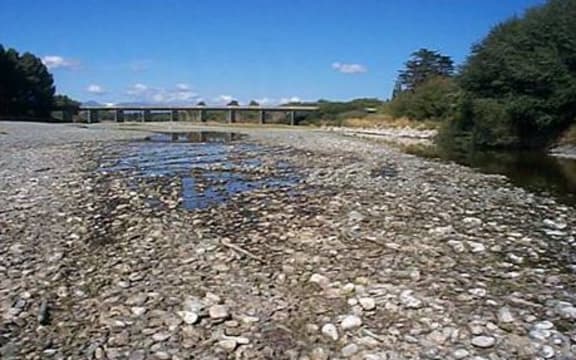Water shortages could cost the Nelson-Tasman region $700 million over 25 years in lost production if a planned large dam is not built, a report says.

A dry Waimea River by the Appleby Bridge. Photo: Tasman District Council
The $80m Waimea Community Dam has been on the drawing board for more than a decade, but there has been disagreement over funding.
The new report was commissioned by Waimea Irrigators Limited, a company that has the backing of a group of large horticulturists and the Tasman District Council.
The region's mayor, Richard Kempthorne, said it took into account the opportunities a dam would open up for new crops and the impact that doing nothing would have on current water users, such as apple and grape growers.
"Without additional water we cannot allow further development. Also what it's quantified is the impact on the current irrigators and it's very significant.
"So the current horticultural operations would be significantly compromised without additional water."
He said as well as bringing an economic benefit to the region, it would also solve the long-term problem of where ratepayers could source drinking water from.
On this basis, a $25 million ratepayer contribution was justified, he said.
But he would not be drawn on whether the council would also act as a guarantor for a $25 million loan from the government's Crown Irrigation Fund for the project.
"It was commercially sensitive information that was in committee, so I can't really tell you any more of the detail than that. The important thing is there is no expectation for the general ratepayers in the district to be covering the financial costs of irrigators."
A spokesperson for Waimea Irrigators Limited, former Solid Energy chairman John Palmer said the report showed the region could not afford to not build the dam.
"Tasman District have urban and industrial water problems that they have to deal with over the next 20-plus years and clearly doing nothing is not an option for them. Nelson City have similar problems and doing nothing is not an option for them."
But Brian Halstead, an accountant and consultant for 15 irrigators in the district, said talk of $700 million worth of economic benefits from future development was the stuff of fantasy.
"We can't really see a rapid uptake of dry land, unless there's a new crop on the horizon that we don't know about.
"Really the report is fiction when it comes to estimating the composition of the 1800 hectares of dry land to be converted.
"The demand for water simply wasn't there as growers pulled out their water thirsty pip fruit trees and replaced them with grapes, which required far less watering and reaped a better return," he said.
"Water has not been a limiting factor in the district at all. Water use in the past 10 years has been relatively constant. So they can't necessarily say that there's a huge demand for the water for additional crops."
Mr Halstead said the growers he represented did want to see some increase in the amount of water able to be used for irrigation - just not on the scale being proposed.
The $80 million cost could not be justified, he said.



